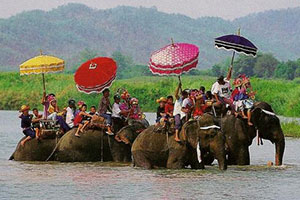Rating: 3.2/5 (10 votes)
Ordination Tradition

Opening days: Daily
Opening hours: 08.00 - 17.00
Ordination Tradition The time of the Thai Sart Festival falls on the 15th day of the waning moon of the 10th lunar month.
It is held on 7-8 April of every year at Hat Siew Temple, Hat Siew Sub-district. Si Satchanalai District Sukhothai It is a tradition of Haad Siew villagers who are Thai Phuan people. who migrated from the city of Phuan Mueang Xieng Khouang Province, North of Vientiane City, Laos.
Important traditions in Sukhothai Elephant Parade and Nak Ordination Tradition Haad Siew Si Satchanalai District Sukhothai.
The villagers call it "Ordination Elephants", a traditional elephant ordination ceremony on Haad Siew Beach. It is a tradition of Haad Siew villagers who are Thai Phuan people. who migrated from the city of Phuan Xiangkhouang Province, north of Vientiane City, Laos. Once settled in the present place, it has continued to carry on its own good traditions for more than 150 years.
The Thai Phuan people have special beliefs from "Vessantara Chad" that the Buddha was born, is the day that the white elephant was important "Elephant factors nakendra" which can influence the fall according to the season Complete the crops and become a majestic elephant, Phra Vessantorn and the city's family. The Naga sits on the elephant's back and then paraded into that procession It is imitated from the story of Lord Vessantorn riding an elephant.
The event will be held for 3 days, which is the day of Souk Dip, the day of the Naga parade (the highlight of the event) and the ordination day. The host's relatives will go out to "Tiao Ban", which is to walk to make merit at the relatives of Ban Mit to invite them to join the event. Those who will go out to visit the house must dress in traditional clothes on the day of the festivities. as well as entertainment, the next day (April 7 of every year), which is the day of the Naga parade In the morning, relatives help each other shave their hair, shave their eyebrows, take a shower and dress the otters.
After that, let the otter go to receive the precepts from the monks at the temple near the house, then go home and change the white naga clothes. Dress up as a crystal ball in beautiful colored traditional clothes. wearing various gold and silver rings Put on beautiful eye makeup, wear dark glasses, put on the head and sit holding incense sticks and candles on the elephant's neck. which has been bathed beautifully dressed and then moved the parade out of the house Come to the end at Wat Haad Siew After that, let the Naga go down on the elephant's back to pay homage to the shrine in the temple and enter the church for religious ceremonies. When the procession of all Nagas is complete, they will join a large procession around the village. and then dispersed back home.
The next day is "Ordination Day", so the Nagas go to ordain at the temple. according to Buddhist ceremonies Or there may be an ordination ceremony in the evening after the elephant parade is finished by monks. The Thai Phuan people call it "Chao Sua" and the novice calls it "Jua Ai".
![]() Category: Art, Culture and Heritage
Category: Art, Culture and Heritage
![]() Group: Art, Craft Centres, Tradition
Group: Art, Craft Centres, Tradition
![]() Last Update : 5 MonthAgo
Last Update : 5 MonthAgo


